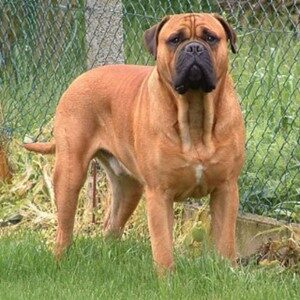Best Dog Bed for Bullmastiff
A Bullmastiff Needs a Comfortable Bed!
Introduction
Best dog bed for Bullmastiff take into account their health condition, sleeping style and preferences. An orthopedic memory foam bed is best for their weight. The Bullmastiff is a majestic, powerful, and affectionate breed that has captured the hearts of dog lovers worldwide.
Originally bred in the 19th century as a “Gamekeeper’s Night Dog” in England, Bullmastiffs were tasked with guarding estates and apprehending poachers. Known for their imposing stature, protective instincts, and calm demeanor, they quickly earned a reputation as reliable guardians and loving family companions.
Bullmastiffs are large dogs, often weighing over 100 pounds, with a distinctive black mask and a short coat that comes in fawn, red, or brindle. Despite their size and strength, they are gentle giants with a deep loyalty to their families.
These dogs are not overly energetic but require regular exercise to stay healthy. Their calm and affectionate nature makes them excellent with children, but their size and protective instincts require responsible ownership and early training. Owning a Bullmastiff comes with both rewards and responsibilities.
While their low-maintenance grooming needs and gentle temperament make them ideal for many families, prospective owners must be prepared for their drooling, strong will, and susceptibility to certain health issues.
Socialization and consistent training are crucial to raising a well-mannered Bullmastiff who thrives as part of the family. Whether as a steadfast guardian or a devoted companion, the Bullmastiff’s unique combination of strength, loyalty, and affection makes them a beloved breed. With proper care, they can bring years of joy, love, and protection to their owners.
In this guide we cover information that new owners should be aware of with this breed. The topics include best dog bed types, brands, common health conditions, behavior concerns, tips for new owners, costs of ownership, and safe foods and foods to avoid.
Video: Pros and Cons of A Bullmastiff
This is an excellent video of the pros and cons of owning a Bullmastiff. You may want to view this video prior to owning this dog to determine if you should own one.
Best Dog Bed Types These beds focus on comfort, durability, and support for their large size and potential joint issues:
- Orthopedic Dog Beds
-
Why? Provides excellent support for Bullmastiffs, especially for aging dogs or those prone to hip and joint issues.
- Features to Look For:
- Memory foam or high-density foam.
- Non-slip base to prevent sliding.
- Large enough to accommodate their size (XL or XXL).
- CertiPUR-US Seal: When shopping for a memory form bed, look for the CertiPUR-US seal. The seal means that the materials used do not contain any toxins or chemicals that are harmful to pets and humans.
- Elevated Cot-Style Beds
- Why? Great for airflow and keeping Bullmastiffs cool, especially in warmer climates.
- Features to Look For:
- Sturdy metal or PVC frame.
- Durable, chew-resistant fabric.
- Easy to clean and maintain.
- Bolster Beds
- Why? The raised edges give Bullmastiffs a sense of security and a place to rest their heads.
- Features to Look For:
- Reinforced bolsters to withstand their weight.
- Machine-washable covers.
- Generously sized sleeping area.
- Pillow or Cushion-Style Beds
- Why? These oversized beds provide ample space for Bullmastiffs to sprawl out.
- Features to Look For:
- Durable, washable covers.
- Extra padding for comfort.
- Tear-resistant materials.
- Waterproof or Washable Beds
- Why? Easy to clean and maintain, especially for drooly or messy Bullmastiffs.
- Features to Look For:
- Waterproof liners.
- Removable and washable covers.
- Heavy-Duty Chew-Resistant Beds
- Why? Ideal for younger Bullmastiffs that may chew during their teething phase.
- Features to Look For:
- Durable materials like ballistic nylon.
- Reinforced stitching.
- Resistant to digging and scratching.
Best Dog Bed Brands
- Orthopedic Dog Beds
- Brands:
- Big Barker 7″ Pillow Top Bed
- Price: $250–$400 (designed for large breeds, comes with a 10-year guarantee).
- PetFusion Ultimate Dog Bed
- Price: $120–$300 (memory foam with bolsters, water-resistant cover).
- FurHaven Orthopedic Chaise Lounge
- Price: $60–$150 (affordable option with egg-crate foam).
- Big Barker 7″ Pillow Top Bed
- Elevated Cot-Style Beds
- Brands:
- Coolaroo Elevated Pet Bed
- Price: $40–$70 (breathable fabric, resistant to fleas and mildew).
- K&H Pet Products Original Pet Cot
- Price: $50–$100 (sturdy frame, easy to assemble, available in large sizes).
- Kuranda Dog Bed
- Price: $150–$250 (heavy-duty chew-resistant option, ideal for strong dogs).
- Coolaroo Elevated Pet Bed
- Bolster Beds
- Brands:
- BarksBar Snuggly Sleeper
- Price: $100–$200 (orthopedic foam with reinforced bolsters).
- Majestic Pet Poly-Cotton Bagel Bed
- Price: $80–$200 (deep cushioning with durable fabric).
- Frisco Plush Orthopedic Bolster Bed (Chewy Exclusive)
- Price: $50–$150 (budget-friendly, supportive design).
- BarksBar Snuggly Sleeper
- Pillow or Cushion-Style Beds
- Brands:
- K9 Ballistics Tough Rectangle Bed
- Price: $150–$250 (durable, chew-resistant, machine-washable cover).
- MidWest Quiet Time Couture Tufted Bed
- Price: $50–$100 (simple, soft, and affordable).
- Mammoth Large Breed Dog Bed
- Price: $200–$300 (extra-large sizes with durable fabric).
- K9 Ballistics Tough Rectangle Bed
- Waterproof or Washable Beds
- Brands:
- Bedsure Waterproof Dog Bed
- Price: $40–$80 (budget-friendly, fully washable).
- K&H Pet Products Memory Foam Waterproof Bed
- Price: $80–$150 (memory foam with a waterproof liner).
- Brindle Waterproof Orthopedic Pet Bed
- Price: $70–$120 (soft cover with waterproof lining).
- Bedsure Waterproof Dog Bed
- Heavy-Duty Chew-Resistant Beds
- Brands:
- K9 Ballistics Chew Proof Elevated Bed
- Price: $120–$250 (guaranteed chew-proof, raised design).
- Chew Proof Armored Dog Bed by Gorilla Dog Beds
- Price: $200–$350 (industrial-strength materials, designed for large breeds).
- Ruff n’ Tuff Indestructible Dog Bed
- Price: $100–$250 (durable and resistant to chewing and scratching).
- K9 Ballistics Chew Proof Elevated Bed
Facts and Fun Facts About the Bullmastiff Measurements:
- Size: Large
- Group: Working Group
- Height Male: 25 – 27 inches
- Height Female: 24 – 26 inches
- Weight Male: 110 – 130 lbs.
- Weight Female: 100 – 120 lbs.
- Length Male: 40 – 44.5 inches
- Length Female: 40 – 44.5 inches
- Lifespan: 7 – 9 years
- Fully Grown: 5 years
- Colors: Fawn, Fawn Brindle, Red, Red Brindle, Red Fawn, Red Fawn Brindle
- Popularity: This breed is the 60th most popular in the United States according to the American Kennel Club in 2023.
- Intelligence: This breed is ranked the 69th most intelligent according to Professor Stanley Coren at the University of British Columbia.
Facts
- Origins as Gamekeeper’s Dogs
Bullmastiffs were bred in the 19th century to guard estates and protect gamekeepers from poachers. Their lineage is a mix of 60% Mastiff and 40% Bulldog.
- Natural Guardians
Bullmastiffs are instinctively protective but not overly aggressive. They tend to act only when they sense real danger, making them excellent family guardians.
- Silent Yet Effective
Unlike other watchdogs, Bullmastiffs often rely on their sheer size and presence instead of barking. They’re more likely to pin intruders rather than attack.
- Minimal Exercise Needs
While they need daily exercise to stay healthy, Bullmastiffs aren’t high-energy dogs. A moderate walk or some playtime is usually sufficient.
- Sensitive Souls
Bullmastiffs don’t respond well to harsh training methods. They thrive on positive reinforcement and a calm, consistent approach.
- Heat Sensitivity
They are prone to overheating due to their short muzzles. Owners should avoid overexerting them in hot weather and always provide a cool environment.
- Drool Alert
Bullmastiffs are known for their drooling, especially after eating or drinking. New owners should keep towels handy!
- They’re Couch Potatoes
When not patrolling their space, Bullmastiffs enjoy lounging around and can adapt well to indoor living despite their size.
- Independent Thinkers
They can be a bit stubborn, which can make training challenging for first-time owners. Early socialization and training are crucial.
- Family-Oriented
Despite their intimidating appearance, Bullmastiffs are gentle and affectionate with their families, including children. They’re happiest when included in family activities.
- They Were Bred To Be Guard Dogs
The Bullmastiff was created in England in the 1860s by crossing a Mastiff with a Bulldog. The goal was to create a guard dog that would defend wealthy properties from poachers trying to steal game, like deer. The Bulldog-Mastiff-cross provided the Bullmastiff with the perfect balance of aggression and speed necessary to apprehend the thieves.
Fun Facts Here are some fun facts about Bullmastiffs that showcase their charm and unique traits:
- The “Silent Watchdog”
Unlike many guard dogs, Bullmastiffs rarely bark! Instead, they rely on their intimidating appearance and calm demeanor to ward off intruders.
- They Have Celebrity Fans
Bullmastiffs have been owned by celebrities like Marlon Brando and Sylvester Stallone. Stallone even featured his own Bullmastiff, Butkus, in the Rocky films!
- Poacher Pinchers
Originally nicknamed the “Gamekeeper’s Night Dog,” Bullmastiffs were trained to silently track and pin down poachers until their owners arrived.
- Colorful Coats
Bullmastiffs come in three standard coat colors: fawn, brindle, and red. Their distinctive black masks give them an elegant, regal look.
- They’re Big Lap Dogs
Despite weighing over 100 pounds, many Bullmastiffs think they’re lap dogs and won’t hesitate to climb onto your couch—or your lap—for snuggles.
- Famous in Movies
A Bullmastiff named “Swagger” became the official mascot for the Cleveland Browns football team. The breed also appears in movies like See Spot Run and Rocky.
- Surprisingly Fast
For such a large dog, Bullmastiffs can reach impressive speeds when needed. This agility is a throwback to their poacher-chasing days.
- Super Loyal
Bullmastiffs are so devoted to their families that they’ve been known to shadow their humans around the house like massive, furry bodyguards.
- They Love Kids
Known as gentle giants, Bullmastiffs are incredibly patient and protective of children, often forming strong bonds with the youngest members of the family.
- Foodies at Heart
Bullmastiffs love their meals—and snacks! They can be prone to overeating, so owners need to monitor their diet to prevent weight issues.
- A Nose for Mischief
Their keen sense of smell helps them sniff out treats (or trouble) from across the house. Don’t leave snacks unattended!
- An English Heritage
Bullmastiffs were first bred in England and are considered one of the quintessentially British breeds, with roots tied to estate guarding during the Victorian era.
Common Health Conditions
Here’s a list of the most common health conditions that Bullmastiffs may face, along with brief descriptions to help new owners stay informed:
1. Hip Dysplasia
A common issue in large breeds, hip dysplasia occurs when the hip joint doesn’t develop properly, leading to pain, arthritis, and reduced mobility.
2. Elbow Dysplasia
Similar to hip dysplasia, this condition affects the elbow joint, causing lameness and discomfort, particularly in young Bullmastiffs.
3. Bloat (Gastric Dilatation-Volvulus)
Bullmastiffs are prone to bloat, a life-threatening condition where the stomach twists and traps gas. Quick veterinary intervention is essential if symptoms like a distended belly and unproductive vomiting occur.
4. Cancer
Bullmastiffs are susceptible to certain types of cancer, such as lymphoma and osteosarcoma (bone cancer), especially as they age. Regular check-ups can aid in early detection.
5. Heart Disease
Subaortic stenosis (SAS), a narrowing of the aorta, is common in Bullmastiffs. It can lead to heart murmurs and reduced blood flow, requiring careful monitoring.
6. Hypothyroidism
An underactive thyroid can cause weight gain, lethargy, and skin issues. This condition is typically managed with medication.
7. Entropion
This is an eyelid issue where the lid rolls inward, causing irritation from eyelashes rubbing against the eye. Surgery can correct severe cases.
8. Cherry Eye
Bullmastiffs can develop “cherry eye,” where the gland of the third eyelid prolapses and appears as a red bulge. Surgery is often needed to resolve it.
9. Joint Problems
Osteoarthritis and other joint issues can develop as Bullmastiffs age, particularly if they’ve experienced joint injuries or conditions like dysplasia earlier in life.
10. Skin Problems
Their short coat can make them prone to skin allergies, irritations, and infections, especially in moist environments or if not groomed properly.
11. Obesity
Due to their love of food and lower activity levels, Bullmastiffs can easily become overweight, which exacerbates joint issues and other health problems.
12. Heat Intolerance
Their brachycephalic (short-nosed) structure makes Bullmastiffs susceptible to overheating. Owners should limit exercise in hot weather and ensure access to cool areas.
How to Help Your Bullmastiff Stay Healthy:
- Schedule regular vet visits for check-ups and vaccinations.
- Monitor their diet to maintain a healthy weight.
- Provide joint supplements (as recommended by your vet) to support mobility.
- Ensure they get moderate exercise and a comfortable, cool environment.
Behavior Concerns
Here’s a list of behaviors that new Bullmastiff owners should be aware of to better understand and manage this unique breed:
- Protective Instincts
Bullmastiffs are natural guardians and may be wary of strangers, especially around their family. Proper socialization is crucial to ensure this trait doesn’t lead to overprotectiveness.
- Low Energy Indoors
Despite their size, Bullmastiffs are quite calm and laid-back indoors. They’ll happily lounge on the couch or follow you from room to room, often referred to as “gentle giants.”
- Stubborn Streak
Bullmastiffs can be independent and stubborn, making training a challenge for new owners. Consistent, positive reinforcement is key to overcoming their willful nature.
- Drooling
Drooling is a hallmark of the breed, especially after drinking or eating. Owners should be prepared to wipe drool regularly and keep drool towels handy.
- Gentle with Family
Despite their intimidating size, Bullmastiffs are incredibly affectionate and gentle with their family, including children. They thrive on companionship and don’t do well when left alone for long periods.
- Separation Anxiety
They can develop separation anxiety if left alone too often. This may result in destructive behaviors like chewing furniture or excessive barking when stressed.
- Slow Maturity
Bullmastiffs take longer to mature than many other breeds. While they may physically appear full-grown, their mental maturity can lag, making consistent training essential throughout their adolescence.
- Food Motivation
Bullmastiffs are highly food-driven, which can be useful in training. However, this also means they may beg, counter-surf, or even steal food if given the chance.
- Non-Barking Guardians
Unlike traditional watchdogs, Bullmastiffs don’t bark much. They rely on their presence and physical intervention rather than vocalizing, which can surprise new owners expecting a more vocal guard dog.
- Clinginess
These dogs are often described as “Velcro dogs” because they love to stay close to their humans. They might follow you from room to room and prefer to always be in your company.
- Playful Yet Gentle
Bullmastiffs enjoy playtime but are typically gentle and mindful of their size, especially with children. However, they can unintentionally knock over small kids during bouts of excitement.
- Territorial Tendencies
Bullmastiffs can be territorial about their home and yard. Early socialization and exposure to various environments can help reduce over-defensiveness.
Tips for New Owners
Here’s a list of helpful tips for potential new Bullmastiff owners to prepare them for life with this loving and protective breed:
1. Start Socialization Early
Introduce your Bullmastiff to various people, animals, and environments from a young age. This helps them become confident and well-mannered adults, reducing any overprotective tendencies.
2. Prioritize Obedience Training
Bullmastiffs are strong and can be stubborn. Begin obedience training early using positive reinforcement to establish good behavior and a strong bond. Consistency is key!
3. Manage Their Size
Teach basic commands like “sit” and “stay” early, as their large size (100–130 lbs) can make untrained behaviors difficult to handle.
4. Be Prepared for Drool
Bullmastiffs are heavy droolers, especially after eating or drinking. Keep towels or drool cloths handy and be ready for their slobbery love.
5. Moderate Exercise Needs
They’re not high-energy dogs but still need daily walks and some playtime to stay healthy. Avoid overexertion, especially in hot weather, as they can overheat easily.
6. Provide a Comfortable Space
Due to their size, Bullmastiffs need a spacious, sturdy dog bed and room to stretch out. A cozy spot near the family works best since they thrive on companionship.
7. Monitor Their Diet
Bullmastiffs are prone to obesity, which can worsen joint problems. Feed them a high-quality diet in controlled portions and avoid overindulging with treats.
8. Regular Health Checkups
Schedule regular vet visits to monitor for breed-specific conditions like hip dysplasia, bloat, and heart issues. Early detection is critical to managing these problems.
9. Keep Them Cool
With their short snouts, Bullmastiffs are prone to heatstroke. Avoid vigorous activity during hot weather and always provide access to shade and fresh water.
10. Set Boundaries with Children
Bullmastiffs are gentle with kids, but their size can be overwhelming for small children. Teach both the dog and children to interact respectfully and safely.
11. Secure Your Home and Yard
As natural guardians, Bullmastiffs can be territorial. Ensure your yard is securely fenced, and establish clear boundaries to prevent them from patrolling too widely.
12. Be Prepared for a Velcro Dog
Bullmastiffs love being close to their humans and can develop separation anxiety if left alone too often. They thrive in homes where they can be part of the family’s daily life.
13. Grooming is Easy but Regular
Their short coat requires minimal grooming—just weekly brushing to reduce shedding and maintain their skin health. Check ears, teeth, and nails regularly too.
14. Early Crate Training Helps
Crate training not only gives them a safe space but also helps manage their large size in the home. Make the crate a positive place for them.
Costs of Ownership
Here’s an overview of the average costs of owning a Bullmastiff to help you budget appropriately. Keep in mind that costs can vary depending on location, the dog’s specific needs, and personal preferences.
Initial Costs
- Purchase Price or Adoption Fee
- Breeder: $1,500–$4,000 (for a reputable breeder with health-tested puppies).
- Adoption: $200–$500 (from shelters or rescues).
- Initial Vet Visit
- Average: $100–$300 (includes vaccinations, health checks, and deworming).
- Spaying/Neutering
- Average: $200–$500 (depending on the size of the dog and your location).
- Basic Supplies
- Large Dog Crate: $100–$300.
- Dog Bed: $50–$150 (sturdy and large enough for their size).
- Bowls: $20–$50 (heavy-duty or no-tip options work best).
- Collar and Leash: $20–$50.
- Toys and Chews: $50–$100 initially.
- Training Classes
- Group classes: $100–$300 (for basic obedience).
- Private training: $50–$100 per session (for specific behavior needs).
Recurring Costs
- Food
- Monthly: $60–$100 (large-breed, high-quality kibble).
- Annually: $720–$1,200.
- Veterinary Care
- Annual check-up: $200–$400.
- Vaccines: $50–$100 per year.
- Flea/Tick/Heartworm prevention: $20–$50 monthly ($240–$600 annually).
- Grooming
- Minimal grooming needs; supplies like brushes and shampoo: $50–$100 annually.
- Pet Insurance
- Monthly: $40–$80.
- Annually: $480–$960 (covers accidents, illnesses, or hereditary conditions).
- Miscellaneous
- Replacement toys: $100–$200 annually (Bullmastiffs are strong chewers).
- Poop bags, cleaning supplies: $50–$100 annually.
Potential Extra Costs
- Health Issues
- Joint supplements: $20–$50 per month ($240–$600 annually).
- Emergency vet visits: $500–$3,000 (unplanned expenses like bloat or injury).
- Boarding or Pet Sitting
- Boarding: $30–$75 per day.
- Pet sitting: $20–$50 per visit.
- Professional Training (if needed)
- Advanced training or behavioral consultations: $500–$1,000+.
Summary of Annual Costs
- Low Estimate: $1,500–$2,500.
- High Estimate: $3,000–$5,000+ (including pet insurance and potential medical needs).
Tips to Manage Costs:
- Invest in Quality Early: High-quality food, training, and preventative care can reduce long-term health costs.
- Consider Pet Insurance: It can offset significant expenses if unexpected health issues arise.
- Adopt When Possible: Rescues often cover initial vetting and spaying/neutering.
Safe Foods and Foods to Avoid
Here’s a comprehensive guide to safe foods and foods to avoid for Bullmastiffs (and dogs in general). This can help keep your Bullmastiff happy and healthy while preventing harmful accidents:
Proteins
- Cooked Chicken (no bones or seasoning)
- Cooked Turkey
- Cooked Lean Beef
- Fish (like salmon or sardines, boneless and cooked).
Fruits
- Apples (remove seeds and core).
- Blueberries
- Bananas
- Watermelon (seedless).
- Strawberries
Vegetables
- Carrots (raw or cooked).
- Green Beans (plain, steamed, or raw).
- Sweet Potatoes (cooked, no seasonings).
- Pumpkin (plain, cooked, or canned—not pie mix).
- Broccoli (in small amounts, steamed).
Grains & Dairy
- Plain White or Brown Rice
- Oatmeal (plain, cooked).
- Plain Yogurt (unsweetened, unflavored).
- Cheese (small amounts, low-fat varieties like mozzarella).
Foods to Avoid
Some foods are toxic or harmful for Bullmastiffs and should be avoided entirely:
Toxic Foods
- Chocolate
- Contains theobromine, which is toxic to dogs. Dark and baking chocolate are especially dangerous.
- Grapes and Raisins
- Can cause kidney failure.
- Onions, Garlic, and Chives
- These can damage red blood cells and cause anemia.
Dangerous Additives
- Xylitol (in sugar-free gum, candy, or peanut butter)
- Causes a dangerous drop in blood sugar and can lead to liver failure.
- Caffeine
- Found in coffee, tea, and some energy drinks; can cause restlessness and heart issues.
Fats and Bones
- Cooked Bones
- Can splinter and cause choking or internal injury.
- Fatty or Fried Foods
- High-fat foods can lead to pancreatitis.
Dough and Alcohol
- Raw Dough (Yeast Dough)
- Can expand in the stomach, causing bloat or other serious issues.
- Alcohol
- Even small amounts can lead to toxicity or death.
Miscellaneous
- Avocado
- Contains persin, which can upset their stomachs.
- Macadamia Nuts
- Can cause weakness, tremors, and hyperthermia.
- Ice Cream
- Many dogs are lactose intolerant, and sugary treats aren’t healthy.
General Feeding Tips for Bullmastiffs
- Avoid Overfeeding: They’re prone to obesity, so watch portion sizes and limit treats to 10% of their daily calorie intake.
- Monitor for Allergies: Some Bullmastiffs may have food sensitivities, particularly to grains or proteins like chicken.
- Feed on a Schedule: Two meals per day is ideal to avoid bloat. Don’t allow vigorous activity immediately after meals.
Conclusion
Bringing a Bullmastiff into your life is a decision that promises love, loyalty, and companionship but also requires dedication and preparation. As a breed with an ancient lineage rooted in protection and family devotion, Bullmastiffs have retained their noble and affectionate traits, making them wonderful additions to households that can meet their needs.
The Bullmastiff’s calm nature, low-maintenance grooming, and remarkable patience with children make them ideal for families.
However, their sheer size and strength come with responsibilities, including early training, proper socialization, and consistent boundaries. These dogs thrive when they are treated as part of the family, enjoying close bonds with their humans and displaying a “Velcro dog” tendency to follow their owners everywhere.
Potential owners must also consider the breed’s health and maintenance needs. Regular veterinary care, a balanced diet, and exercise tailored to their size and energy levels are essential for keeping Bullmastiffs healthy.
Their predisposition to conditions like hip dysplasia, bloat, and heart issues underscores the importance of preventative care and awareness. Beyond practical considerations, owning a Bullmastiff is an emotionally rewarding experience.
Their unwavering loyalty and protective instincts make them natural guardians of the home, while their affectionate and gentle demeanor creates deep, lifelong bonds with their families.
Ultimately, the Bullmastiff’s combination of strength, elegance, and kindness makes them a breed like no other. They are dogs with big hearts, ready to love fiercely and unconditionally.
For those who are willing to provide the care, patience, and commitment this breed requires, the Bullmastiff will repay you with unparalleled devotion, protection, and joy for many years to come.
Check out our article on the most popular dog breeds in the United States by clicking on the link.
Shop Dog Beds
Shop dog beds for your dog by selecting or clicking on any bed of choice. You will be taken to Amazon where you can read customer reviews and answered questions and place the order.
As an Amazon Associate, I earn from qualifying purchases. Your purchase price is the same as if you shop directly on Amazon.
The price at time of publish is included below to give you an idea of what the price is; however, it is subject to change.
Cooling Gel Dog Beds
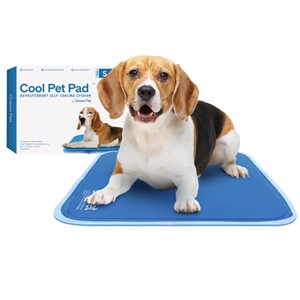
The Green Pet Shop Cooling Mat
Price At Time of Publish $40.00
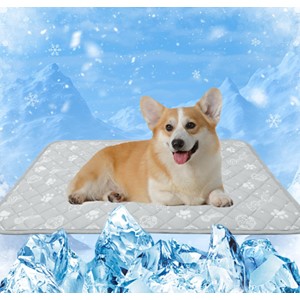
MH MYLUNE HOME Self Cooling Mat
Price At Time of Publish $40.00
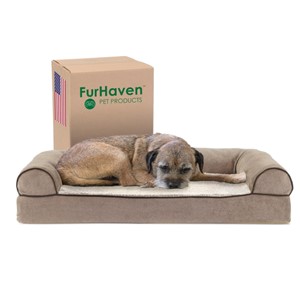
Furhaven Pet Products Cooling Gel Bolsters Small Bed
Price At Time of Publish $45.00
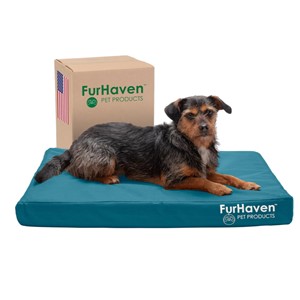
Furhaven Cooling Gel Medium Bed
Price At Time of Publish $42.00

ARF Pets Cooling Gel Pad
Price At Time of Publish $35.00
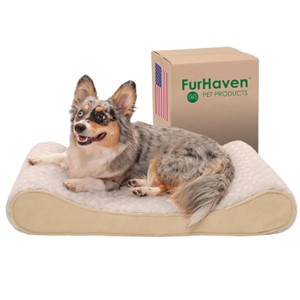
Furhaven Cooling Gel Small Bed
Price At Time of Publish $50.00
Price At Time of Publish $50.00
Orthopedic Dog Beds
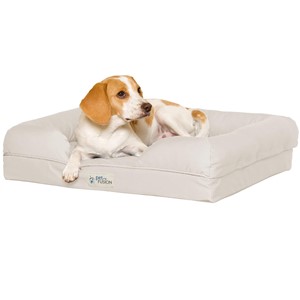
PetFusion Orthopedic Dod Bed
Price At Time of Publish $80.00
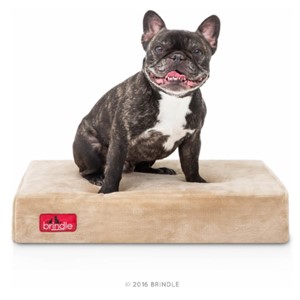
Brindle Orthopedic Bed Khaki
Price At Time of Publish $30.00
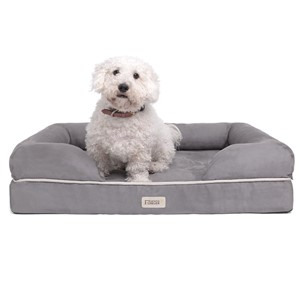
Friends Forever Orthopedic Bolster Bed
Price At Time of Publish $53.00
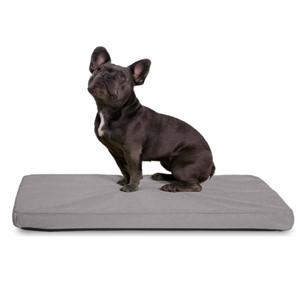
K9 Ballistics Tough Orthopedic Small Crate Bed
Price At Time of Publish $89.00
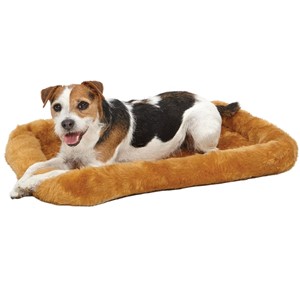
MidWest Homes Small Bolster Dog Bed
Price At Time of Publish $10.00
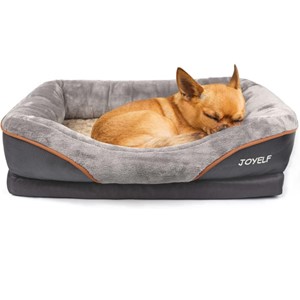
JOYELF Orthopedic Small Sofa Bed
Price At Time of Publish $40.00
Bolster Dog Beds
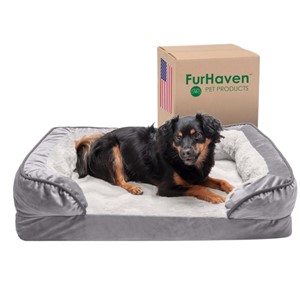
Furhaven Small-Medium Bolster Dog Bed
Price At Time of Publish $57.00
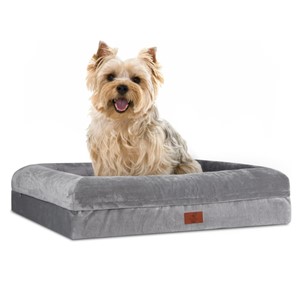
Yiruka Small Bolster Sofa Dog Bed
Price At Time of Publish $40.00
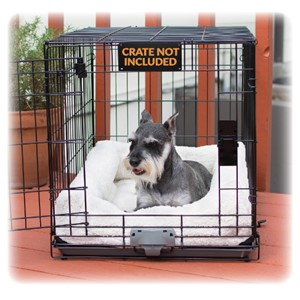
K&H Pet Products Bolster Crate Pad
Price At Time of Publish $22.00
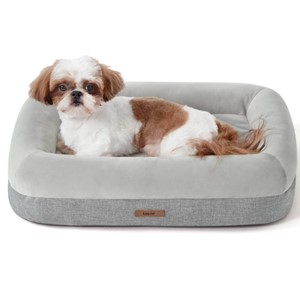
Leasure Small Bolster Dog Bed
Price At Time of Publish $40.00
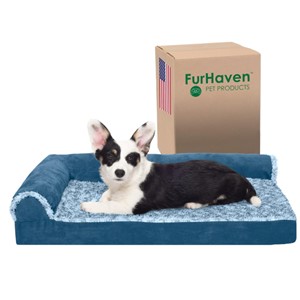
Furhaven Small-Medium L-Shaped Bed
Price At Time of Publish $39.00
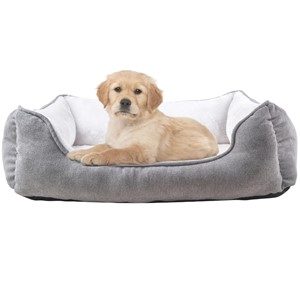
Long Rich Bolster Small Bed
Price At Time of Publish $27.00
Elevated Dog Beds
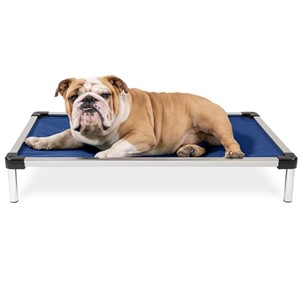
K9 Ballistics Chew Proof Elevated Small Bed
Price At Time of Publish $129.00
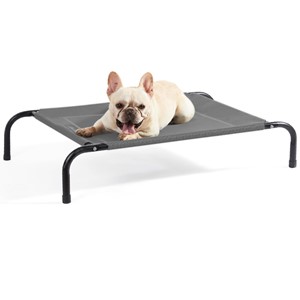
Bedsure Medium Elevated Dog Bed
Price At Time of Publish $33.00
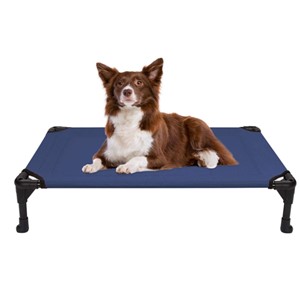
Veehoo Medium Elevated Dog Bed
Price At Time of Publish $45.00
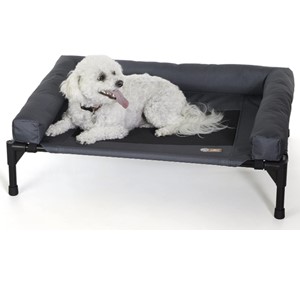
K&H Pet Products Elevated Bolster Dog Bed
Price At Time of Publish $57.00
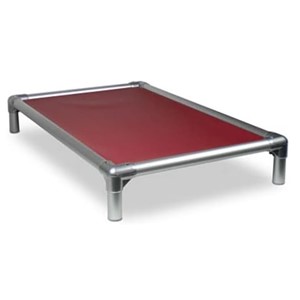
Kuranda Elevated Chew Proof Small Dog Bed
Price At Time of Publish $134.00
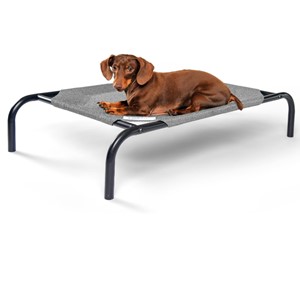
Coolaroo Small Elevated Dog Bed
Price At Time of Publish $21.00
Shop Cave/Donut Dog Beds
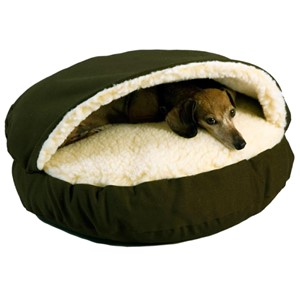
Snoozer Cozy Cave Bed
Price At Time of Publish $87.00
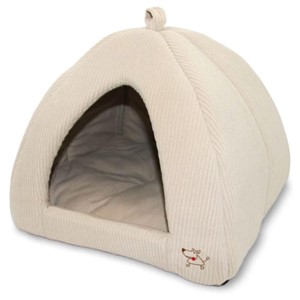
Best Pet Supplies Tent Bed
Price At Time of Publish $23.00
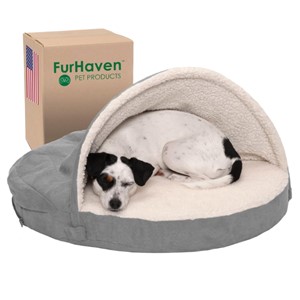
Furhaven Round Orthopedic Cave Bed
Price At Time of Publish $30.00
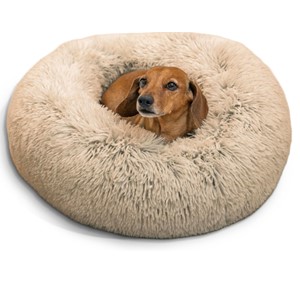
Best Friends by Sheri Original Calming Donut Bed
Price At Time of Publish $25.00
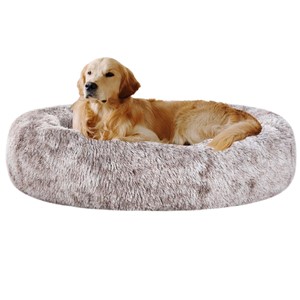
Coohom Oval Calming Donut Cuddler Bed
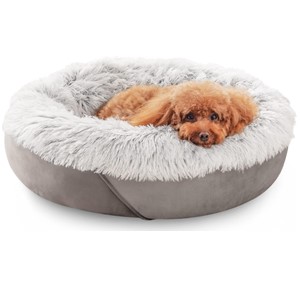
JOEJOY Calming Donut Small Dog Bed
Price At Time of Publish $33.00
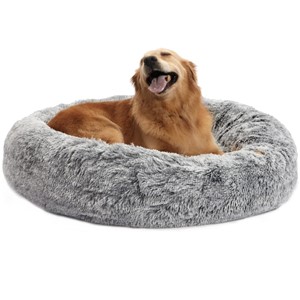
Bedfolks Calming Donut Dog Bed
Price At Time of Publish $66.00
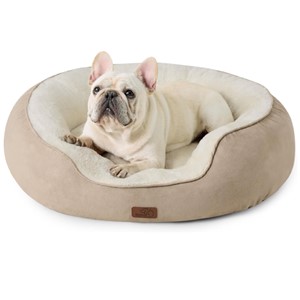
Bedsure Medium Donut Dog Bed
Price At Time of Publish $36.00

Bedsure Medium Donut Dog Bed
Price At Time of Publish $40.00
Related Articles
Below are some other articles you may be interested in reading. Just select on the topic of interest to learn more about it.
- Best Healthy Dog Food Brands
- Christmas Presents for My Dog
- Crates for Dogs
- Critical Signs Your Dog Needs Help
- Dog Training Techniques
- How To Train a Puppy
- Positive Reinforcement for Dog Training
- Puppy Proofing Your House
- Training Dog with Treats
- Using Alexa for Dog Behaviors
Go back to the Dog Luxury Beds home page.
